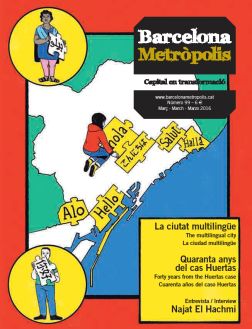 Barcelona, ciutat simbòlica
Barcelona, ciutat simbòlica
[Barcelona: a symbolic city]
Author: Miquel de Moragas Spà
Barcelona City Council
Barcelona, 2016
The city transmits a wealth of information that one must know how to interpret. Urban design is amongst the transmitters: a reinterpretation of a particular understanding of the space in which we must live and make things happen. To walk around a city is to continuously decode both obvious and hidden meanings.
Emerging out of the notion that cities are places for living in (an idea as questioned today as it is revived) is a scenario that will impact us throughout this century: the city as a central theme of political, social and cultural debate. In this book Miquel de Moragas Spà, Professor of Communication at the Universitat Autònoma de Barcelona, explores different aspects of communication and semiotics as they have existed in Barcelona from the 1930s to the present.
Cities are a subject of study in various disciplines. This plurality reflects the richness and complexity that cities bring to our lives. Urban semiotics analyse human communication used by different individuals and groups in a single city over a period of time. To live (in) a city is to interpret messages (walk here, buy this, remember to, etc.), to adapt to these codes and even to play a part in creating new meanings.
The city transmits a wealth of information that one must know how to interpret. Urban design is amongst the transmitters: a reinterpretation of a particular understanding of the space in which we must live and make things happen. But there are also meanings in monuments (To what? By whom? Why? When?), pavements, materials, street furniture, signage and architecture, and in so many other things. To walk around a city is to continuously decode both obvious and hidden meanings.
De Moragas analyses the image and the images that enable us to be in contact with Barcelona. Because contact is not just about living there; it is also about the image that we have of the city before we set foot in it for the first time. Barcelona is a source of communicative images, from the early icons and postcards to the semantic abbreviations of Barça, sea and Gaudí. A more profound examination reveals a city rich in messages, discourse and urban quality whilst in a constant state of evolution and debate. Superimposed images: symbols of the people who experience them first hand.
We should not confuse the city’s ability to communicate with the fact that it is the scene and the museum of its own history. Obviously, the pieces of information that the city transmits (its name being one example) are the result of specific historical contexts. But it is, in fact, the shape taken by this history and this intent to communicate. Often the city itself is a message that explains certain meanings. One example is: could the Olympic Games have been held without first cleaning up the building facades and the “Barcelona, posa’t guapa” [Barcelona, make yourself pretty] campaign?
The contact one has with Barcelona is influenced by the formats used to transmit messages, by our ability to interpret them and by the context and moment we are in. The city of Barcelona conveys itself through audiovisual messages and languages that describe it to external audiences, to strangers.
Barcelona attracts and seduces and is the subject of photographs, films, engravings, novels, poems and songs. To learn to read it is to learn to interpret these creations and to differentiate between admiration, belonging, criticism, parasitism, propaganda and speculation.



